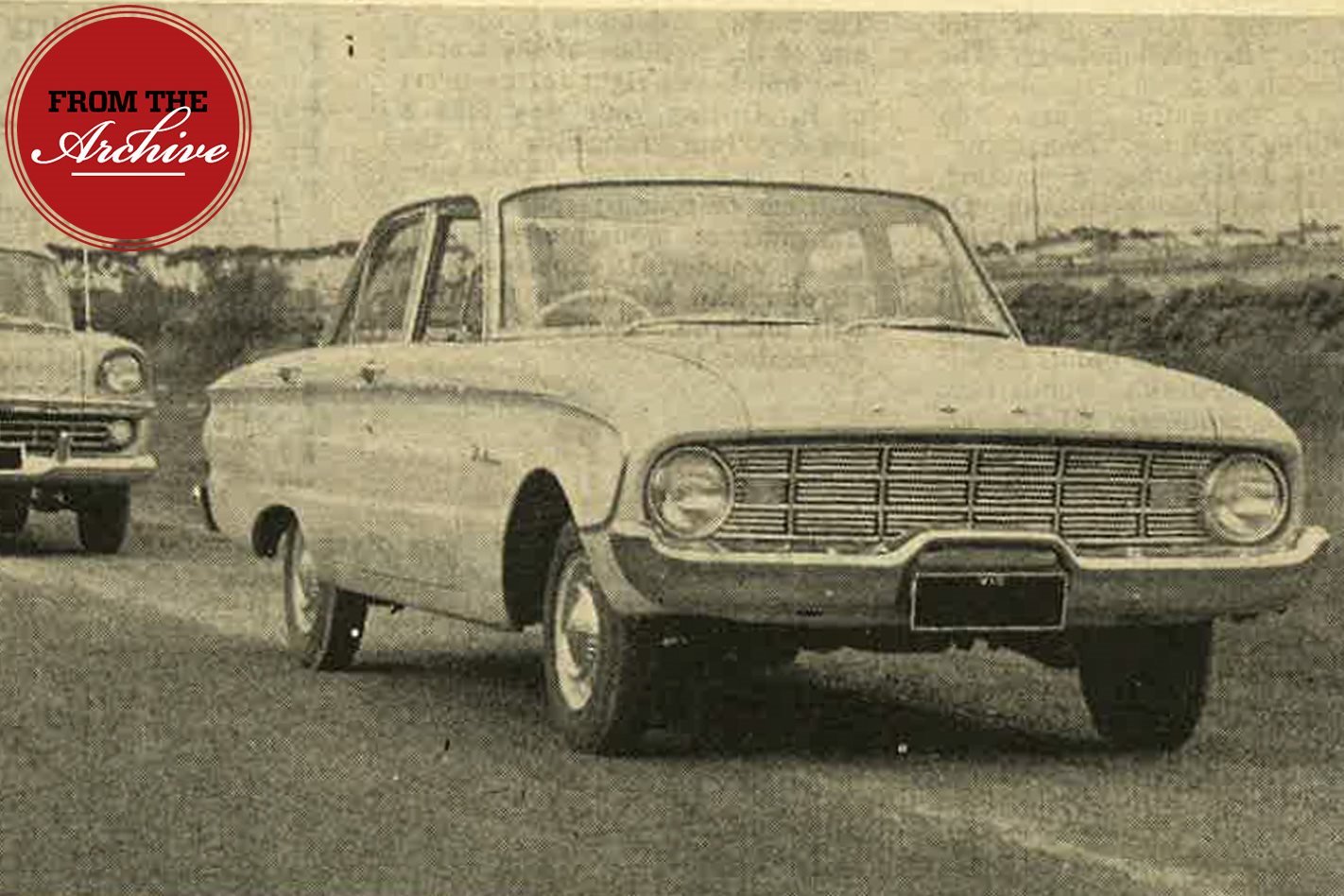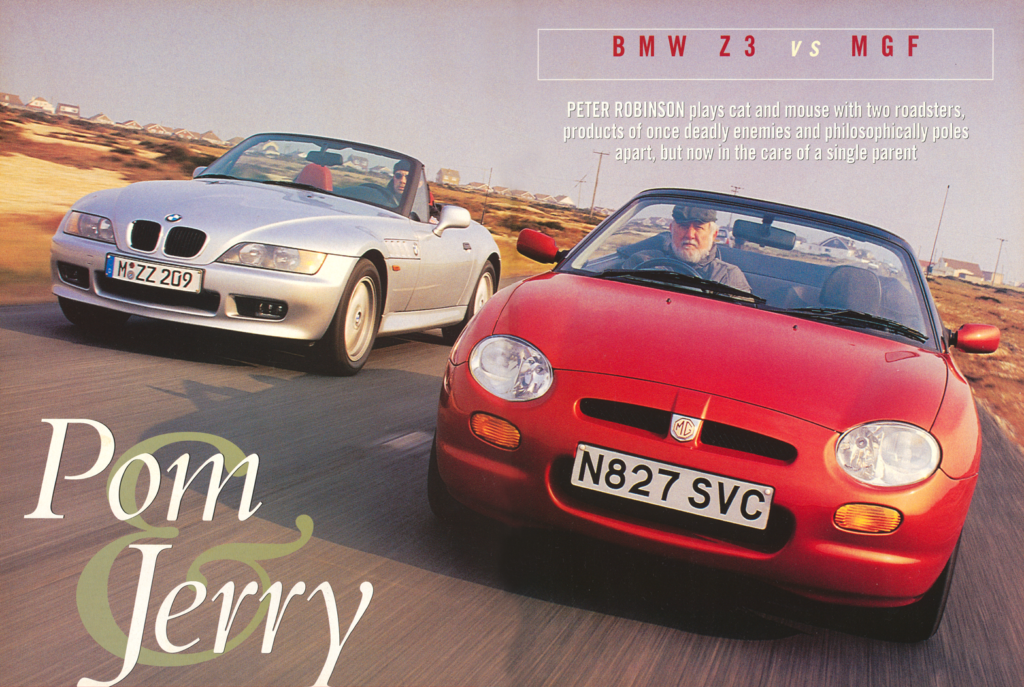First published in the October 1960 issue of Wheels magazine, Australia’s best car mag since 1953.
The question on the lips of the majority of Australian motorists at the moment is “how do the Ford Falcon and Holden FB compare?
To find out exactly, WHEELS staffmen put both cars through rigorous tests, side by side.
Read Ian Fraser’s classic story, as published in the October 1960 edition of Wheels.
To an extent, perhaps, the findings are largely personal opinions which have been discussed and argued out by the writers.
One of the first things to realize is that both the cars are substantially the same, designed to do the same kind of job and costing very much the same. Neither car is a revolutionary design, both being very sound examples of conventional automobilism.
Holden has the advantage of having had the current series in production for several years and the standard of finish and workmanship has evolved through sheer excellence. Against this, the Falcon is something new for Ford and it is being manufactured in a new plant. Nevertheless its standard of finish is good, but not up to that of the Holden. Eventually it will be.
After we bad completed the tests we seriously asked ourselves which was the better car overall. We concluded that the Falcon was slightly superior in most aspects, some of them so subtle that many people would not even notice. And of course, the Falcon should be good since it was designed by one of the biggest motor companies in the world and it was designed very recently. It is also a car which will not date quickly since the style is not radical, Ford has made the effort to manufacture a car to compete directly with Holden and have spared no effort to make sure it does. As you can see in the various sections there is not much to pick between them.
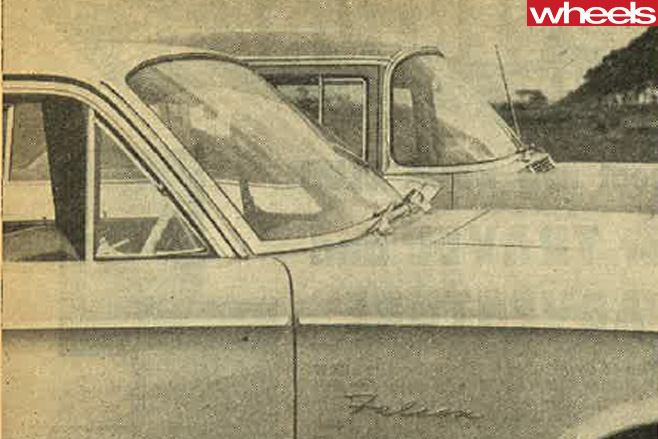
Falcon: So much speculation has cropped up about the price of the Falcon that the professional, educated guessers made estimates from £20 less than the Holden to £100 more. Ford, naturally enough, kept very silent about the whole business until release day, then popped the answer to the question Australian motorists have been asking for months – £30 more than the Holden in every case. However, the price list was supplemented by additional figures for the automatic transmission version – £119 more than the standard gearbox models.
Ford has insisted on advertising their new baby at the list price without tax, so here it is: The cheapest version sells for £909, or £1137 with tax fob Ford plants. Deluxe goes off for £959, or £1199 with tax, fob Ford plants.
For automatic transmission prices just add £119 to the tax inclusive price.
Holden: General Motors is a little less fussy about how their prices are described, usually quote only the total figure. The standard Holden sells for £1107 and the Special for £1169. So far there is no auto transmission available for the Holden, but when there eventually is one, it will probably cost about the same as the one fitted to the Falcon.
Why isn’t the Falcon the same price as the Holden, or maybe even cheaper? Firstly, that would have probably started a price war which no one would want and GMH would probably be the only ones who could afford it.
Secondly, I think Ford hopes that the slightly greater price will influence people into thinking that the Ford’s long awaited, much talked-about Falcon costs more because it is a better car. Well, maybe that angle will work, maybe it will not – time will tell.
Seriously, though, these cars are in direct competition with each other — £30 makes absolutely no difference specially when you consider that most cars will be bought on hire purchase and the difference is then reduced to about £6.
PERFORMANCE
Falcon: The acceleration and top speed figures recorded on the performance page speak for themselves. The Falcon is definitely fastest and that is all there is to it.
The short stroke engine is smooth and flexible, but no more so than that of the Holden. Being low-geared, the Falcon will pull up very steep gradient in top gear with ease, even when fully laden.
Holden: Well, the Holden is not going to be as good in traffic-light drag racing as it used to be. If there is a Falcon in sight, the Holden had better step back.
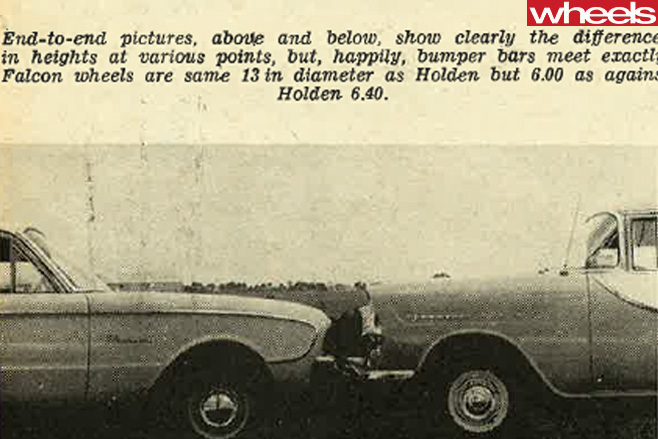
Falcon: About the first thing a new driver (new to the Falcon, that is) realises when he slips behind the wheel is that he is sitting low and the controls are all in easy reach.
The steering wheel is big, but also too close to the driver for him to stretch his arms out. Tall people would probably like the steering column shortened by a couple of inches. It is dished and has a horn ring.
The safety element is smartly contradicted by sharp edge of the dashboard in front of the driver. Crash padding – too thin to be of much value – is an optional extra.
Instrumentation is simple – a speedo without trip, temperature gauge and fuel gauge. Warning lights do the rest.
Various types of interior trim are available to the customer’s own choice and it is all comfortable to sit on.
There is ample headroom in the front, but if a six-footer sits upright and leans back in the rear seat, his head is bound to touch the roof.
The Falcon’s seating position is a little like that of a sports car because the driver sits low and looks over a long bonnet which has a power bulge dead centre.
The gear change worked beautifully and felt something like that of a Ford Zephyr – precise with short movements.
Holden: Compared with the Falcon the Holden makes the driver feel as though he is well up in the air He certainly gets a commanding view of the traffic, although the pillars of the windscreen are rather too thick and cause a blindspot.
The steering wheel comes nicely to hand and the gear lever is well placed and in typical fashion works very well apart from shaking badly on rough roads. For speed and smoothness I think the Holden’s cog swapping arrangements are superior to those of the Falcon.
Visibility is generally very good and both the rear fins are clearly visible through the large rear window – a great asset when parking.
There is more headroom in the Holden and the trim is very good, superior to that of the Falcon. Instruments comprise of a speedo with yellow band marker, a fuel gauge and warning lights for oil pressure, temperature and generator.
Like the Falcon, the Holden has vacuum wipers, not notably satisfactory in either car.
Although the FB looks as though it has crashing padding because the top of the dashboard is painted matt black it has the same head-cracking features of the Falcon.
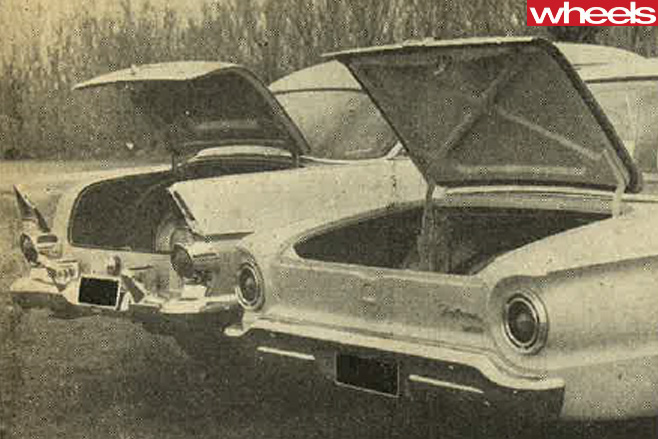
Falcon: Most people are going to say straight off that they prefer the Falcon. It is a modern car, designed specifically for the world market of 1960-61. It has also been designed to look very attractive with as few compromises as possible. The aim has been to fit five or six people in a reasonably comfortable car. This has certainly been achieved and it would appear that the Falcon would be one of the very few popular cars to be released in the world for several years not to have tail fins.
Ford has also been game enough to do away with the complete wrap around windscreen in favor of multi-curved piece of glass through which the driver gets excellent visibility.
The rear window is pretty much the same and while it is certainly practical from most points of view and looks excellent, there is one serious drawback – the summer sun.
I visualise Falcon fans slowly frying in the sun because the stylists have swept the glass at such an angle that it is almost as much overhead as it is dead ahead. Ford will probably make a small fortune selling style-destroying exterior visors and blinds for the rear window.
The Falcon is lower than Australians are used to in big cars. It stands more or less at chest height which, for the record is 55 inches. It is also 181 inches long on a wheelbase of 110 inches.
One major objection put up by saloon-bar theorists is that the Falcon is so low that it is hard to get in and out. In actual fact this is not so. Deliberately looking for this fault, I tried heaving myself in and out in very imaginable way and I must admit that I personally could find no reason to believe that the car was awkward.
All four doors are wide and hinged from their leading edges.
Holden: Let’s face it. The Holden is somewhat dated in spite of various modifications which have been made progressively over the years. The wrap around windscreen, redesigning of the color division and the interior trim have not saved the situation.
Sitting on a wheelbase of 105 inches, the FB Holden has a body 176 inches long and 61 inches high – six inches higher than the Falcon.
Certainly, it is easier to get in and out of the Holden, but that would not be a factor likely to be seriously considered by many potential car buyers.
Getting in and out of the front seat of the Holden is hampered by the dog-leg part of the windscreen frame which threatens the knees of the careless.
However, in spite of the things people are saying about the Holden’s styling it is practical in every respect and passengers are less likely to fry half to death in the summer.

Falcon: By American car standards the Falcon handles very well indeed. By anyone’s standards, satisfactorily most of the time. Being low geared and powerful, the Falcon will come barrelling out bends in a very nippy manner, but the big bug-beat is that low geared steering. Light to use, it is so low geared that even a hero would hesitate to throw the machine around on a gravel road.
Certainly the car sticks well, but when It does eventually let go it is more than a full time job to get the tail back in line. The slow steering just does not permit the driver to keep up with things.
This combined with the car’s inherent understeering characteristics can keep a driver busy if he likes motoring that way.
Body roll is slight and tyre scream is at a minimum. It feels stable on most kinds of corners and the only thing likely to un-nerve passengers is the necessity to wind that wheel.
Holden: General Motors has had plenty of chances to make the Holden handle well and they have.
The steering is more highly geared than the Falcon’s and this factor alone permits the FB to be hustled through corners faster than its opponent.
On test we took careful note just how hard we could push both cars through a given bend on our test circuit. The Holden won by between three and five mph.
However, just how important these factors are to the average motorist is something only he can decide. We were pushing to the limit all the time to get these results. Not many other people would have the inclination or opportunity to do the same thing.
Taken overall, I do consider that the Holden handles better than the Falcon. This is something which is a combination of personal opinion (basically, road tests always are) and actual facts.
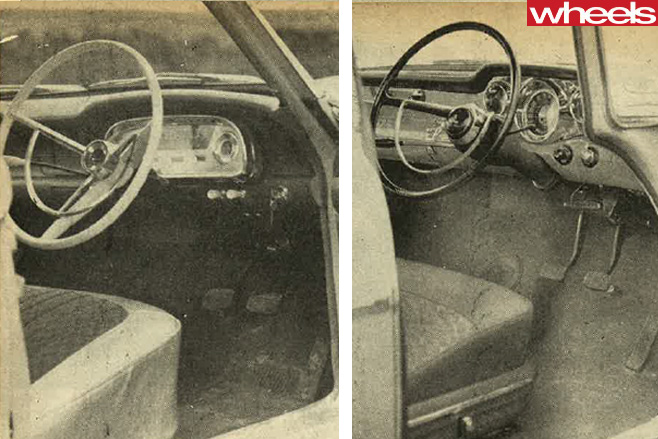
Falcon: To get it clearly on record, neither the Holden nor the Falcon have particularly brilliant brakes.
With a 114.3 square inches of brake lining area, the Falcon stops much better than the Holden from high speeds the first couple of times you do it, but after that fade definitely occurs, pedal pressure becomes higher and the pedal itself feels soft.
Small brake drums are a legacy of small wheels which in turn are necessary for low overall height. (Vauxhall in England recently took an unprecedented step by fitting the new Cresta series with bigger wheels so that they could have larger brakes).
Naturally the brakes are hydraulic and the handbrake is mechanical. The latter is a useless affair and on the models we tried was incapable of seriously retarding the Falcon from 30 mph. Strictly a parking brake, I would not like to rely on it alone on a steep gradient.
To the credit of the Falcon, the foot brake is very light and pleasant to use. The handbrake is under the dashboard on the right hand side. Of the twist and release type, I found it was not particularly well placed mainly because of the necessity to reach well forward to get at it.
Holden: In the past we have often shot at Holden for its brakes. Slightly heavier than the Falcon, the FB’s brakes are also slightly less in area with 112.5 square inches of area. Under the same conditions as the Falcon, the Holden suffered more braking problems, but like the Ford, recovery was fairly quick.
The handbrake worked better and was easier to reach. It could slow the FB with a little more efficiency than the Falcon.
In both cars the pendant-type pedals were too high, necessitating too much of a lift from the accelerator to the brake – could be troublesome in an emergency.
More pedal pressure was required to stop the Holden than the Falcon, but certainly it was not the class of heavy braking as we imagine it in cars made prior to 1950.
This seems a good chance to fire a rocket at quite a few manufacturers who produce cars with brakes which could easily be a lot better.
STEERING
Falcon: This is where the Falcon seems likely to derive the major part of what criticism is thrown at it.
The enthusiast is certain to think dark anti-American thoughts as soon as he takes the Falcon through his first curve.
The five full turns needed to go from lock to lock seem unnecessarily low, to put it very mildly.
To say it more strongly, the low steering ratio seems to have no use greater than being a sop to the vulgarians who imagine that being a motor car driver begins and ends with a glamorous white wheel that is wagged from side to side like an excited dog’s tail on straight roads and whirled like a high performance top on even the mildest corner.
It has no basis in the realms of sensible design on a car that weighs only a ton and has a turning circle of 38 feet.
In fairness it must be said that the low ratio makes parking a low-energy job, but despite the appearance of the centres of our major cities, motorists do not spend all their time parking their vehicles.
One does get used to the steering after a while and makes adjustments for its disadvantages. But on this one point, if no other, Ford could have done a lot better.
Holden: This is one point where Holden wins hands down. Its steering is quit direct and only a fraction heavier than the Falcon’s.
The Holden has a moderate lock-to-lock of 3.8 turns, which seems about ideal for a car of its size and weight. It would be just about right on the Falcon, too.
Holden’s turning circle is 36 ft, a good 24 inches shorter than its rival from Ford.
SPARE PARTS AND SERVICE
Falcon: This is an aspect of motoring where a firm attempting any serious challenge to Holden’s king size grip of the market, has to do things properly.
Over the years since its inception, the Holden has built an outstanding and fully justified reputation for availability and moderate cost of spare parts and service.
The one factor that defeated the original prejudice in the minds of many Australians against the Holden (it was “too small” or “wouldn’t stand up to hard going” or “didn’t have a chassis) was the realisation that came quite quickly that Holdens were easy to fix, did not cost too much in repair bills and could be repaired at almost any garage in any part of Australia.
Volkswagen realised the importance of spare parts availability and efficient service. That is one of the major reasons behind the continued success of the Beetle. Ask any panel beater which are the two most practical cars in Australia. The answer is the same every time – Holden and Volkswagen, because the parts are cheap and always available everywhere.
Ford seem to have realised this important fact ,too. As long ago as mid-July, the Ford company issued every Ford dealer in Australia (and there are more than 600 of them) with a complete stock of Falcon spares. More than 150,000 items went out in what proved to be a massive and successful delivery job.
More than that, Ford seem to have priced their spares right. Indeed, for most items, Ford have gone all the way in their effort to match and beat Holden.
Here is a list of a few typical spare parts for the Falcon, with the Holden prices for similar parts:
| u00a0 | Falcon | Holden |
| Short motor | u00a367/5/- | u00a366/10/- |
| Clutch plate | u00a35/7/6 | u00a35/5/- |
| Front wheel bearing | u00a3116/9 | u00a3117/3 |
| Front shocker | u00a33/17/ – | u00a0u00a33/17/6 |
| Headlamp assembly | u00a34/ 18/- | u00a0u00a36/10/ |
| Front fender | u00a315 | u00a316 |
| Water pump | u00a34/15/- | u00a35/15/- |
| Crankshaft | 26/10/- | u00a326/15/- |
And so it goes on down the parts price list. There is little more than a few shillings difference in the price of comparable bits and pieces of the two models.
On service, too, Ford seem to have taken the logical, sensible, approach.
They are following the trend pioneered in this country by Volkswagen, or issuing coupon booklets for the various services for the first 30,000 miles. The prices charged for each service are set out on each coupon and the exact points to be serviced are listed.
From now on it is up to Ford. They have started well and if they can make certain that their spares prices are strictly policed, that the parts themselves are always available everywhere and that the standards of service provided by their dealers are nothing but the highest, the Falcon cannot fail to do well.
Holden: GMH will not be taking the spares and service aspect of the fight lying down.
On September 1, they began issuing all new Holden owners with service booklets similar to those Volkswagen have been supplying since 1951 and Ford are providing with every Falcon right from the start.

